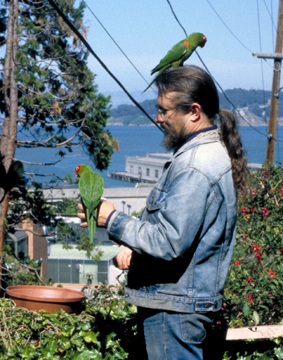 Mark Bittner makes like a latter-day St. Francis with ‘The Wild Parrots of Telegraph Hill.’ (photo by Daniela Cossali)
Mark Bittner makes like a latter-day St. Francis with ‘The Wild Parrots of Telegraph Hill.’ (photo by Daniela Cossali)
|
|
A D V E R T I S E M E N T
|
|
|
|
A D V E R T I S E M E N T
|
|
Birdman Near Alcatraz
A man glimpses the changes of life while caring for The Wild Parrots of Telegraph Hill.
By KRISTIAN LIN
Our best film this week begins in a park in the middle of San Francisco, where we see a flock of birds, perhaps 30 strong, take wing from the treetops, calling out as they fly. And even if you know the story of this movie, it’s still a shock to realize that these are parrots flying around the big northern California city like it’s the South American jungle. The Wild Parrots of Telegraph Hill is in no small measure focused on this unusual flock. It’s also about a man who devotes much of his time and energy to these birds, but neither is the film simply a portrait of him. It’s a gently awe-inspiring vision of life in flux, and it’s 2005’s first truly great documentary.
The parrots are cherry-headed conures, also known as red-masked parakeets, which are native to southern Ecuador and northern Peru. The ones in this flock (technically, the proper collective noun is “company”) are probably descended from a handful of birds that either escaped or were released into the wild. San Francisco winters can be pretty brutal, but these tropical birds can take the cold as long as they have food. This explains why similar companies of wild parrots thrive in places like Chicago and New York. There’s even another group in San Francisco that lives a few miles away, after having been displaced from the Telegraph Hill area by the conures.
The man who has effectively made himself the parrots’ mascot is Mark Bittner, who came to the city as a musician and gave up his creative ambitions without ever taking on a steady job and now lives rent-free in an old cottage on someone else’s property beneath Coit Tower. The more you get to know this soft-spoken, well-read middle-aged man with seemingly no malice in him, the more you understand why the property’s owners can’t imagine telling him to leave. Soon, however, the city is telling him to go, because the house where he stays needs major renovations that’ll make it impossible for him to continue to live there while the work is being done. The parrots won’t be jeopardized, but if Bittner’s not there to look after them, they’ll move someplace else and look after themselves.
The movie is directed by Judy Irving, a filmmaker with long experience filming nature documentaries but none in taking on human subjects. Her profiling of Bittner is hardly objective, as a revelation at the film’s end makes clear, but the man’s charm wins you over just as it did the filmmaker. Although he has no formal training in birdwatching, Bittner has studied the individual members of this company in exhaustive detail, giving the birds names and tracking their relationships. (He published his own memoir about the birds last year, a project he was working on while filming was taking place.) His tattered denim jacket and long, graying ponytail make him easy to typecast, yet he refuses the label of “eccentric.” Indeed, he comes across as deeply sane, never letting his emotional attachment to the birds keep him from seeing that they are wild and belong on their own. His moderate position on environmental matters is frequently backed by quotations from the San Francisco poet Gary Snyder. (“If you want to study nature, start where you are.”)
Anyone who’s spent time around a parrot knows that these birds are highly intelligent and highly social beings, and the ones here make predictably photogenic and funny subjects. Bittner introduces us to some of the main personages in the company, such as Scrapper and Scrapperella, a mated pair whose pulled-out feathers are the result of the female’s neurotic habit. Connor, a grumpy bird from a different species (blue-crowned conure), flies with the cherry heads and defends birds who are sick or injured. There’s also Mingus, the one thoroughly domesticated bird, whose name comes from his irascible temper and his way of bobbing his head from side to side when Bittner plays the guitar, a behavior that makes him look like quite a cool cat.
If the movie began and ended with the man and his birds, it’d be just a cute vignette. However, Bittner’s time as their human companion is coming to an end, and his serene acceptance of this is what gives the film its meditative power. Shortly after he leaves, one of the parrots meets a sudden and horrible death that’s captured by a neighbor in a still photo that’s almost unbearable to see. This stomach punch of a tragic development is presented completely unsentimentally by Irving, who knows as well as Bittner that this is how nature is. Happiness and misery are elusive, and people and birds will adapt to changing circumstances. From its humble story, The Wild Parrots of Telegraph Hill achieves a vision of humanity at one with the natural world, and its calm wisdom is of a rare breed. l
 Email this Article...
Email this Article...

